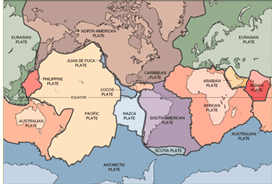the john muir exhibit - lessons - science - grade 6
John Muir Study Guide Science Lesson Plan
Grade Six
Earthquakes
PDF Version of this Lesson Plan
Earthquakes can be one of the most devastating natural disasters on Earth. While in Yosemite in 1872, John Muir experienced a tremendous earthquake that struck the east side of the Sierra Nevada mountains, one of the largest earthquakes to hit California in recorded history. Again in 1906, he felt one of the most devastating earthquakes to hit California in recent times at his home in Martinez. This was the Great San Francisco Earthquake which occurred when there was significant movement along California’s San Andreas Fault.
Objective:
Students will be able to:
- explain that earthquakes are sudden motions along breaks in the crust called faults.
- list the major geologic events including earthquakes, volcanic eruptions and mountain building, which are the result of crustal plate motions.
California Science Standard Grade Six, Earth Sciences:
1d. Students know that earthquakes are sudden motions along breaks in the crust called faults.
1e. Students know major geologic events, such as earthquakes, volcanic eruptions and mountain building, result from plate motions.
Materials:
John Muir on Earthquakes Reading Handout (PDF) (also provided below)
Internet Access
Overhead projector or digital projector
Overhead transparencies or PowerPoint
Preparation:
1. Make an overhead or use the
PowerPoint slide of the World Plate Tectonic Map:

- For Computer Screens, choose your preferred format:
- For printing, choose your preferred format:
- CMYK (2 MB)
- RGB (1.6 MB)
- PowerPoint (1.7 MB) (for printing a transparency or handout.)
Source: U.S. Geological Survey, This Dynamic Earth: The Story of Plate Tectonics
2. Print out the
Fault type diagrams (PDF)
Source: California Geological Survey, California Has its Faults, California Geology (January/February, 1992).
In His Own Words:
Share John Muir’s account of his experience in the 1872 Owens Valley California Earthquake which he experienced while living in Yosemite Valley.
“At half-past two o’clock of a moonlit morning in March, I was awakened by a tremendous earthquake, and though I had never before enjoyed a storm of this sort, the strange thrilling motion could not be mistaken, and I ran out of my cabin, both glad and frightened shouting, ‘A noble earthquake! A noble earthquake’ feeling sure I was going to learn something. The shocks were so violent and varied and succeeded one another so closely, that I had to balance myself carefully in walking as if on the deck of a ship among waves, and it seemed impossible that the high cliffs of the Valley could escape being shattered. In particular I feared that the sheer-fronted Sentinel Rock, towering above my cabin would be shaken down and I took shelter back of a large yellow pine, hoping that it might protect me from at least the smaller out- bounding boulders. For a minute or two the shocks became more and more violent--flashing horizontal thrusts mixed with a few twists and battering explosive upheaving jolts -- as if Nature were wrecking her Yosemite temple, and getting ready to build a better one.”
Source: The Earthquake, excerpted from Chapter 8 of Our National Parks, by John Muir (1901)
Explain to the students that earthquakes are a vibration of the Earth’s crust produced by a rapid release of energy at a focus or place within the crust where an earthquake originates. The epicenter is the place on the Earth’s surface directly above the focus. Earthquakes typically occur when there is sudden movement along a large fracture in the Earth’s crust called a fault, and most of these earthquakes occur along plate boundaries. (Refer to World Plate Tectonic Map)
Using the fault type diagram, describe for the students the three different kinds of faults. In strike-slip faults (also called transform faults when associated with plate boundaries) the rocks move past each other horizontally, whereas, in dip-slip faults (normal and reverse) the movement is primarily vertical.
Explain how the magnitude or intensity of an earthquake is measured by the Richter scale which is determined by the motion of a seismograph. Each increase of one number (example: 5.0 to 6.0) corresponds to a tenfold increase in severity and a 30-fold increase in the amount of energy released.
Activity:
Divide the class into groups of 3 or 4 students and assign each group one of the earthquake events listed below. Using the Internet, have students research this event and describe its location, magnitude, epicenter, and the amount of damage it inflicted. Give the details of the movement that occurred along the fault, and indicate if any tsunamis were generated from the earthquake. Have each group give an oral presentation to the class about the earthquake event they researched.
Suggested earthquake events:
1811 and 1812 New Madrid Earthquakes (8.1, 7.8 magnitudes)
1857 Fort Tejon Earthquake (7.9 magnitude)
1872 Owens Valley California Earthquake (7.6 magnitude)
1906 San Francisco Earthquake (7.8 magnitude)
1960 Great Chilean Earthquake (9.5 magnitude)
1964 Anchorage Alaska Earthquake (9.2 magnitude)
1976 Tangshan China Earthquake (7.5 magnitude)
1985 Mexico City Earthquake (8.0 magnitude)
1989 Loma Prieta California Earthquake (6.9 magnitude)
1994 Northridge California Earthquake (6.7 magnitude)
Extension:
Have the students find the area where they live on the map. Is it an area that is subject to earthquakes? Why or why not? Have them look at places around the country where they may have friends or family, or places they may have previously lived. Do earthquakes occur in these areas? Why or why not?
More Science Lesson Plans
Social Studies Lesson Plans
Lesson Plans
Through the Eyes of John Muir: A Multi-disciplinary Approach to Looking at our World by Janice Kelley
_____________________________
© Copyright 2004 by Sierra Club. Permission to reprint for school purposes is granted to all public and private school teachers. All other rights reserved.
John Muir Study Guide
http://vault.sierraclub.org/john_muir_exhibit/lessons/science/
Home
| Alphabetical Index
| What's New & About this Site